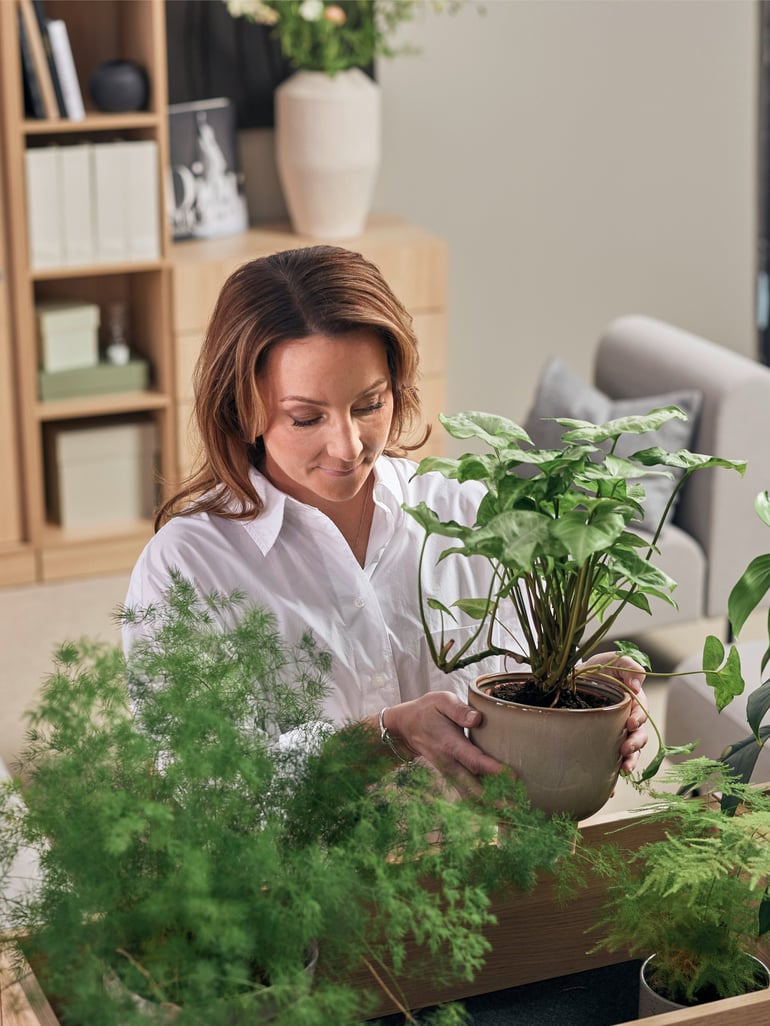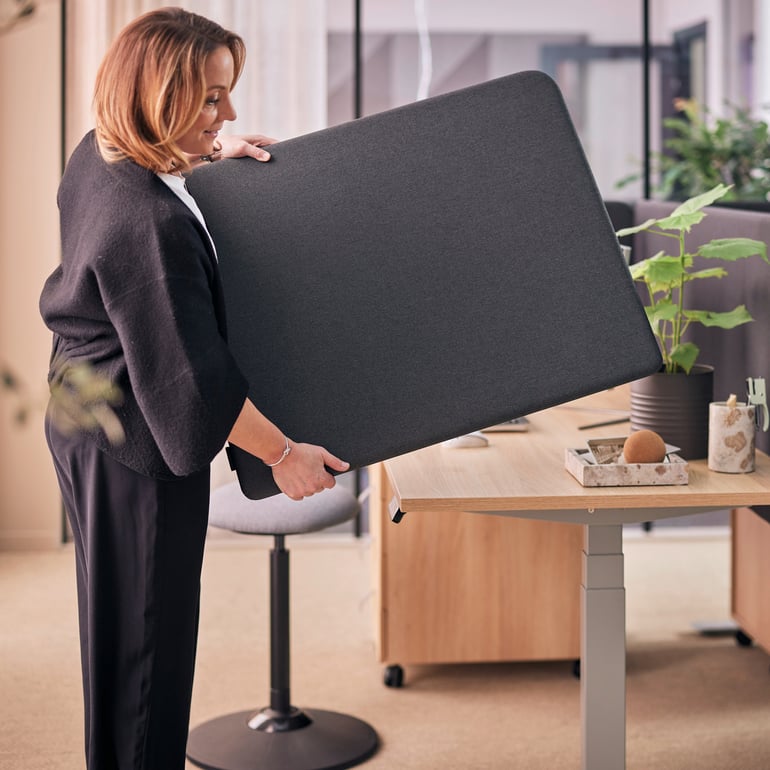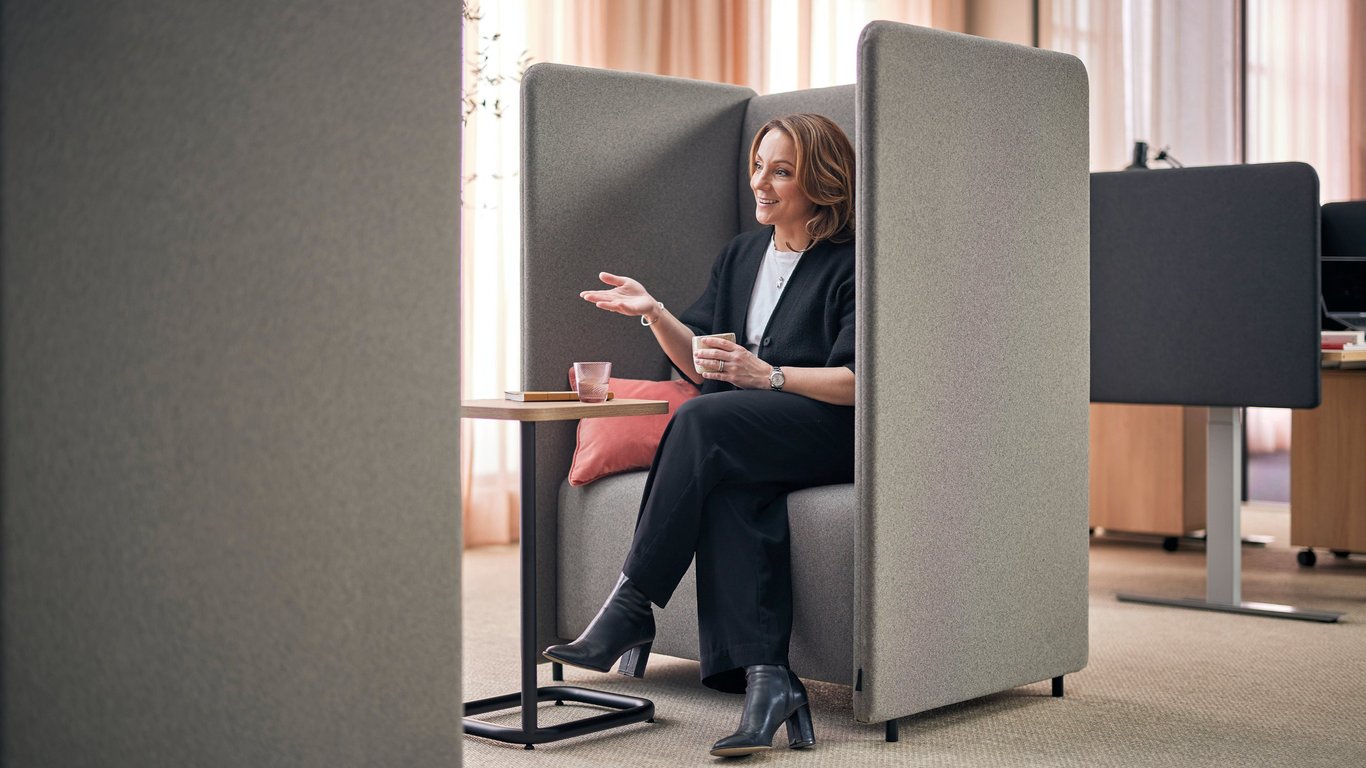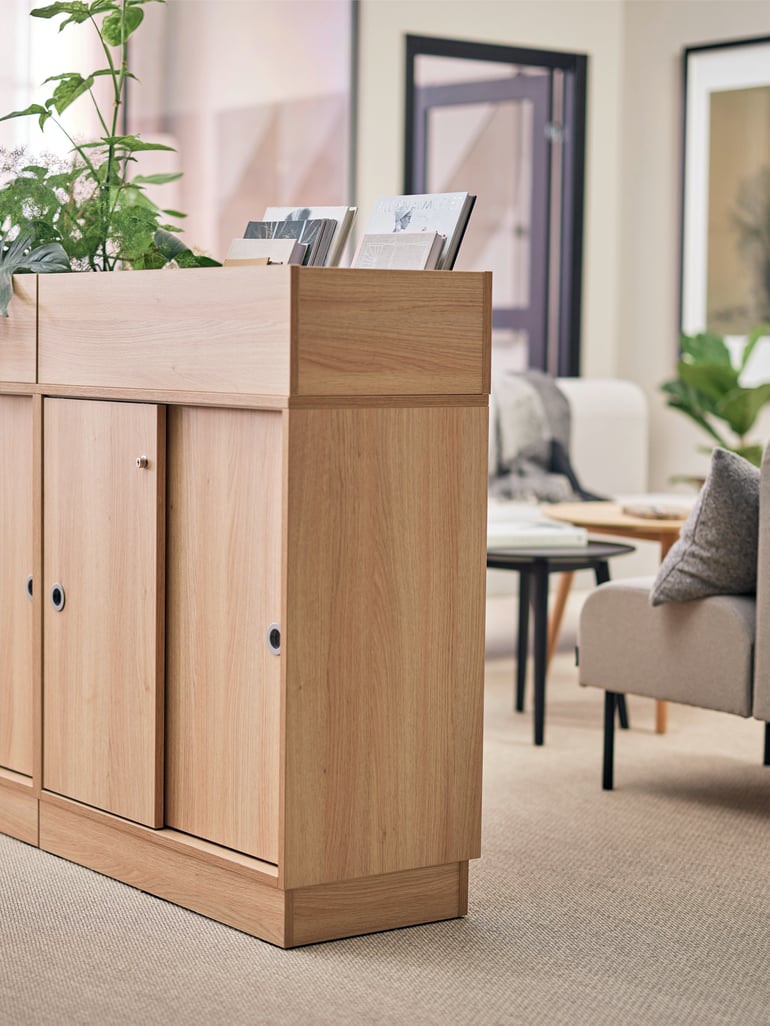- AJ Products UK
- Blog: Tips to Inspire Happiness at Work
- Tips & trends
- 15 Tips for a Productive Office Environment
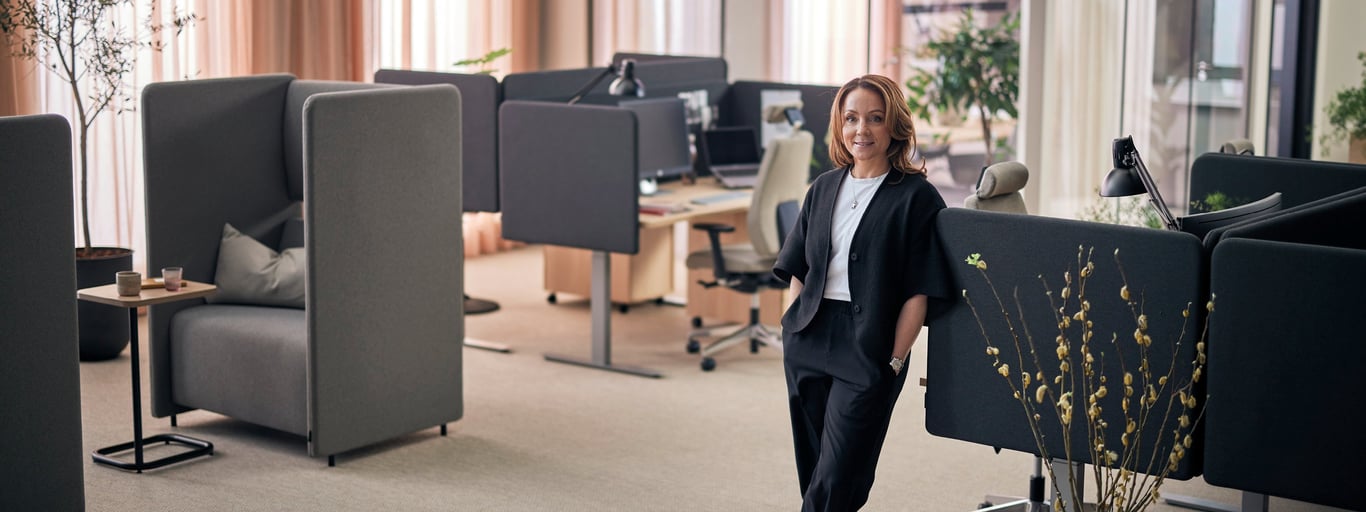
15 Tips for a Productive Office Environment
Guest Blog by Frida Ramstedt of Trendenser
Furnishing an office can be challenging and a significant investment. To create an environment that's both aesthetically pleasing and functional, there’s a lot to consider. Here, I share my top tips for designing a workplace where employees can thrive - from introducing plants and natural elements for harmony, to maximizing focus in open office spaces and choosing the perfect office chair and conference table.
Three tricks to bring some life and warmth into the office
- An easy way to introduce natural elements into an office is by adding plants. However, rather than placing them randomly and hoping for the best, try to create variety by using different leaf shapes and sizes for a more balanced and harmonious look.
- Incorporate details in wood and stone. Furniture that highlights the natural grain of wood or the unique patterns of stone adds a calming, organic touch and breaks up monochromatic surfaces. However, moderation is key - too many irregular patterns can create a sense of restlessness rather than calm.
- Consider varying both materials and textures in a room. Mix smooth glass and painted surfaces with rougher textiles and structured carpets or mats to add character, even if the color palette is monochromatic. This contrast also helps light interact more dynamically with the space, creating natural shadows that add depth, unlike flat, smooth surfaces. Wooden desks don't reflect incoming daylight as sharply as a white surface and offer less risk of glare, nor do they absorb as much light as black desks.
Tips to increase focus in an open plan office
Open office layouts make efficient use of space but can pose challenges for maintaining a peaceful work environment. Here are three tips to help address these issues:
- Working from home can often feel more productive as there are fewer interruptions from colleagues. To create a similar environment at the office, use sound-absorbing partitions between desks. These help block out background noise like conversations and movement around your space, making it easier to focus.
- These screens can also help reduce visual distractions, which is crucial for maintaining focus at work. Even just seeing someone else's clutter, the work they're doing or their body language can prompt you to react and engage, making it harder to concentrate.
- By setting up seating for impromptu meetings away from desks, you encourage people to move there when they need to talk. This helps to minimize disruptions in the open office space and keeps everyone focused.
Sound regulation and the CLEAR SOUND Armchair
There is a lot you can do with furniture to create pleasant acoustics.
- Furnish with soft materials such as carpets and upholstered furniture as they act as sound absorbers.
- Keep in mind that even bookshelves and open storage help to break and spread the sound waves compared to closed cabinets which instead tends to reflect the sound.
- Choose the right furniture. When someone needs privacy, peace and quiet in an open office, an armchair like CLEAR SOUND is the ultimate solution.
- Designate areas for spontaneous discussions, phone calls or digital meetings away from desks to avoid disturbing colleagues.
Three ways to optimise an open floor plan using mobile storage
- To enhance the feeling of spaciousness in an open office, use shelves and cabinets as room dividers. This allows you to create distinct areas within the space. Tip: Opt for wheeled shelves so you can easily rearrange the layout when needed!
- Using low cabinets and bookshelves as barriers in an open office not only creates privacy but also enhances the acoustic environment. Book spines and covers help to break up sound and reduce echo.
- Concealed storage can help minimize distractions. For those who struggle to concentrate in cluttered environments, closed cabinets and drawers can hide items that aren’t currently in use. This not only keeps the space looking tidy but also helps you focus on your tasks without being distracted by unnecessary clutter.
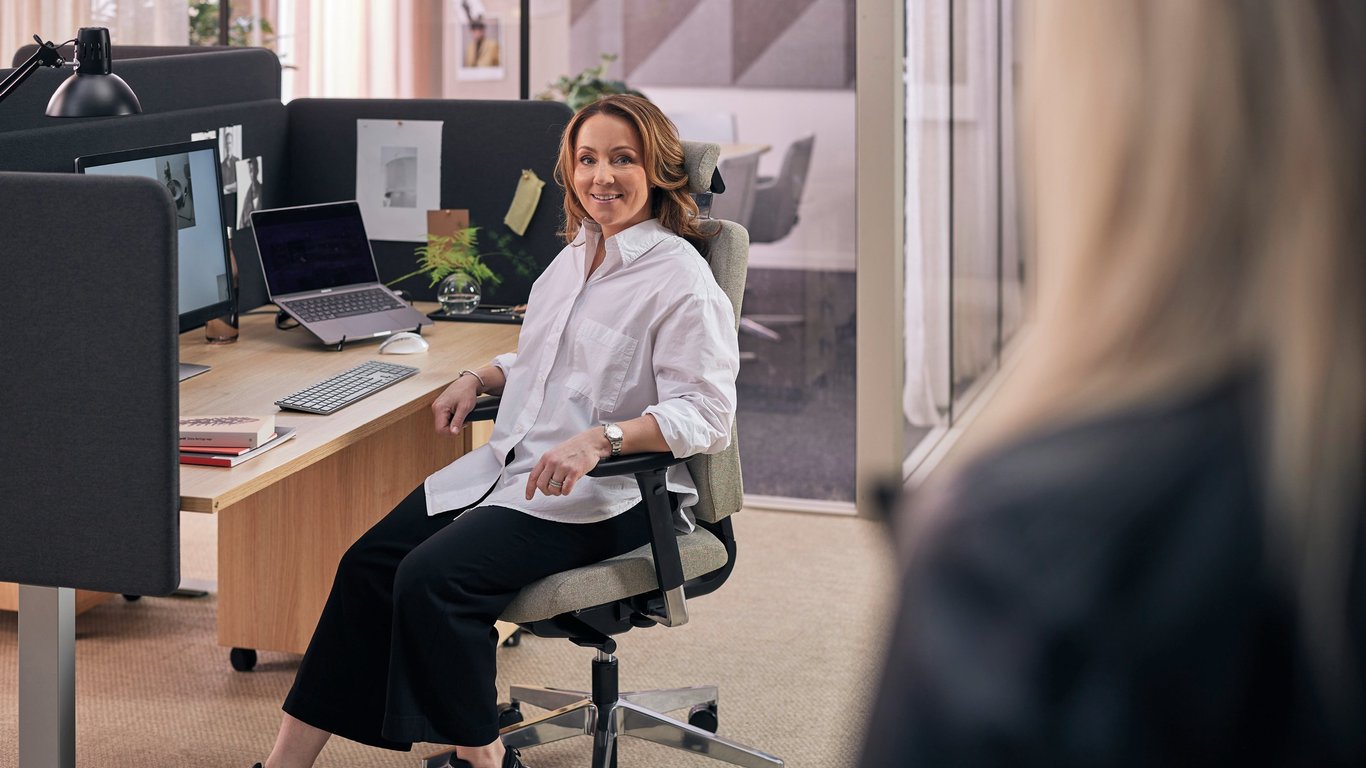
Tips for choosing the right office chair
Do you know what to consider when testing an office chair? Keep this checklist in mind to ensure you don’t overlook any important details:
- Is the chair height adjustable? An office chair should allow you to sit with your feet flat on the floor while keeping your upper body at an appropriate height for the table. This helps prevent wrist strain while typing and ensures your gaze is comfortably aligned with the screen. Since everyone’s body is different, having a chair with adjustable height is essential.
- What is your posture like when you sit down? Does the chair support your lower back, or do you find yourself slumping forward with a bent neck? To reduce strain on your back while working at a desk, it’s important to have a backrest that supports your lower back, allowing you to distribute some of your weight from your lower body to your upper body
- Does the chair seat offer support for your entire thigh? Depending on your leg length, some chairs may feel too small or too large. It's also important to ensure there's a fist-sized gap under your knee at the front of the seat cushion—between the seat and the back of your knee. This space is crucial, as the blood vessels and nerves are located close to the surface there. If the seat presses against this area, it can restrict blood flow and lead to issues like swollen lower legs and feet.
- Are you sitting flat? It's best to choose an office chair that allows you to adjust the seat angle. Ideally, the front edge of the seat should be a few centimeters lower than the back edge, promoting a proper alignment of your back and neck while you work at your desk. The most ergonomic position for desk work is not sitting flat, but rather maintaining a slightly forward-leaning posture
- Can you vary your position? It’s important to change your sitting posture throughout the day. One way to do this is to select a chair that allows you to swivel and has a reclining backrest. This lets you adjust your position when you need a break or when you're on the phone or an online meeting for an extended period
- Are your arms supported? Armrests should be adjusted both vertically and laterally to help relieve strain on your arms and the muscles in your neck and shoulders. If space allows, it's preferable to choose a chair with this feature. However, it's crucial that the armrests can be customised to fit your body and elbow height. Armrests that are too low or too high can lead to discomfort and arm problems.
Did you know?
Changing your working position throughout the day is essential for a healthier work life. It's beneficial to provide employees with different seating options, allowing them to alternate between a classic office chair and active ergonomic seating. You may think that varying your sitting or standing position isn’t significant, but a typical 40-hour work week adds up to 2,080 hours a year!
Five legs is better than four!
Office chairs with five or more legs offer greater stability than those with just four. Chairs with only four legs are at a higher risk of tipping or becoming unbalanced when you shift your weight or reach for something. If a chair has a four-leg base, it’s essential that its design keeps the center of gravity as low as possible to minimize the risk of it tipping over.
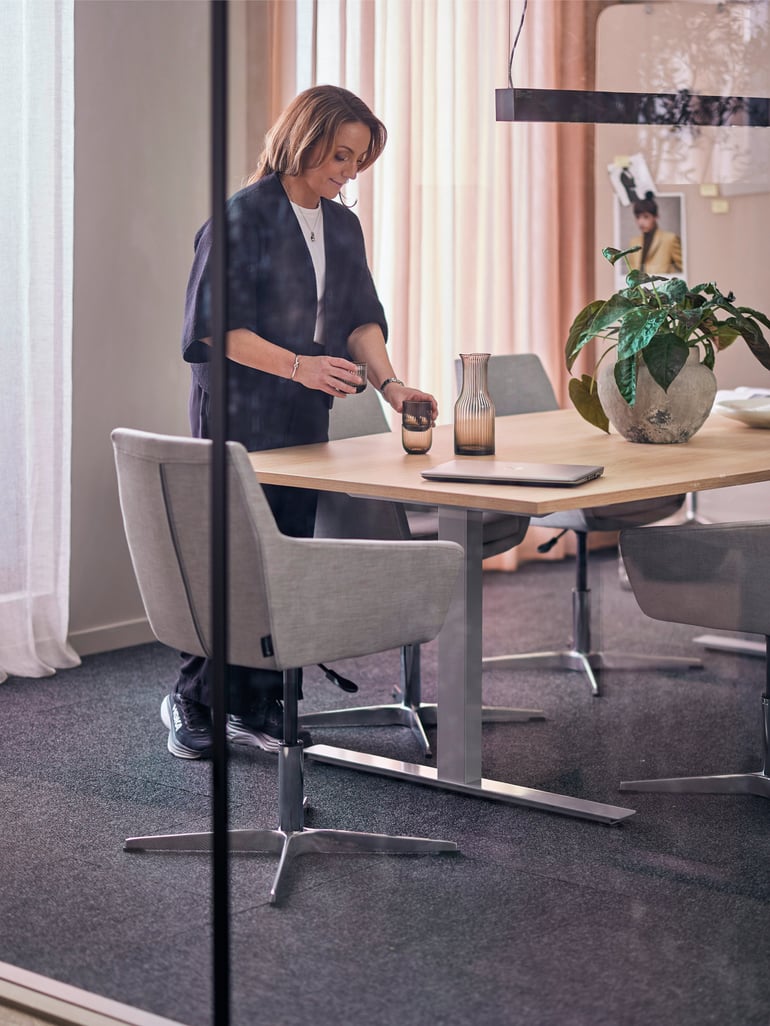
Choosing the shape of your conference table
Round tables
+ Round Tables facilitate eye contact among all participants during meetings.
- However, they can be more space-consuming and require additional room around them for pulling out chairs and sitting comfortably. Not all conference rooms can accommodate this.
Oblong Tables
+ Oblong conference tables are probably the most common type of conference table and are often preferred for meetings with distinct 'customer' and 'company' sides. This setup helps participants quickly identify who works with which party during negotiations or project meetings, especially when attendees are unfamiliar with one another.
- However, oblong tables can create distance between you and the person speaking, making it harder to maintain eye contact and reducing the social interaction in the meeting.
Boat Shaped Tables
+ The boat shape allows those sitting at the edges to have better eye contact with participants in the middle or at the far end of the table. The rounded edges also create a more compact feel compared to an oblong conference table of the same length.
- However, the slightly rounded corners can be a drawback if you need to use the table for larger presentations, as the corners provide less space for spreading out materials like prints and papers."
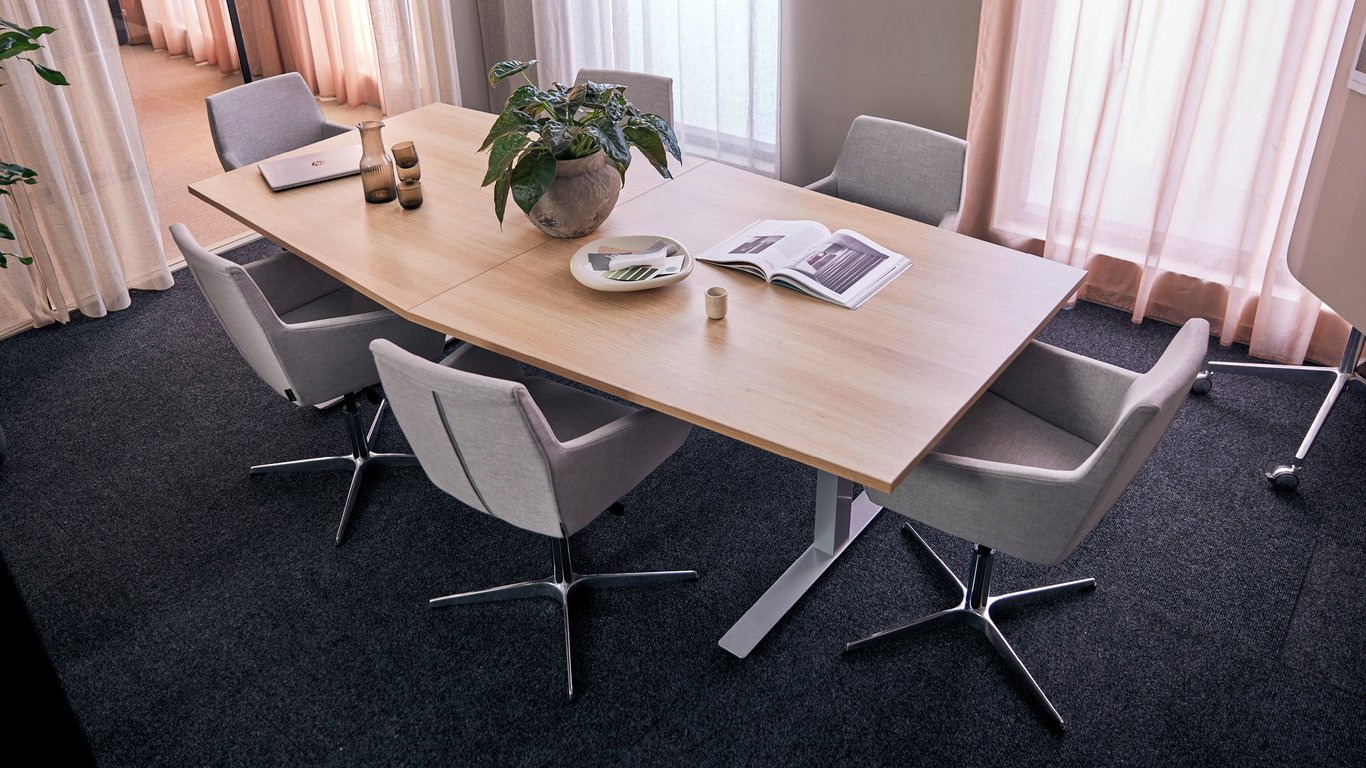
Tips when choosing chairs for the conference room
Correct measurements
Start by checking the seat height in relation to the table height , especially if the chairs aren’t adjustable and will be used in a conference room. As a guide, the distance between the seat surface and the tabletop should be around 27–30 cm. Adjustable chairs are more versatile, as they work with a wider range of tables and help everyone sit comfortably, regardless of height. If you choose one of AJ’s table-and-chair packages, the optimal measurements have already been worked out for you.
Swivel chairs - a more social choice
Chairs that swivel make meetings feel more natural, because you can easily turn towards the person speaking during the meeting. In addition, such models make it easier to alternate positions when sitting for a long time, which can make participants stay more alert and engaged during the meeting.
Avoid leg tangles
Make sure the chair legs and table legs work well together so they don’t become awkward or cramped. Ideally, there should be at least 63 cm of clear space under the table to prevent knees from knocking against table frames or bracing bars. If you opt for a ready-made set, our interior designers will already have considered this.
The right wheels for the right floor
Swivel chairs with castors offer more freedom of movement during conference sessions. Check the wheels, are they right for the surface in the environment where they will be placed? As a rule of thumb: soft castors for hard floors, and hard castors for carpeted or softer floors.
Include all body shapes
What do the chair seats you choose have in terms of shape, width and the furniture's tolerance for maximum weight? Since you are not the only one who will be using the chairs in a meeting room, it is important to consider all possible body types and shapes. No employee or visitor should feel cramped or unsupported.
Think about the multiplication effect
When choosing styles and upholstery, consider how the chairs will look in a group. How does the chair you are looking at look in a group together with many similar ones? Colours appear stronger in large numbers, while shapes feel subtler. Light-colored furniture feels lighter and takes up less of the room's volume. Experiment with the visual weight depending on the room size! Dark upholstery are more forgiving of marks but may show lighter fibres or dust more easily. Think about the visual effect in relation to the size and character of your room.
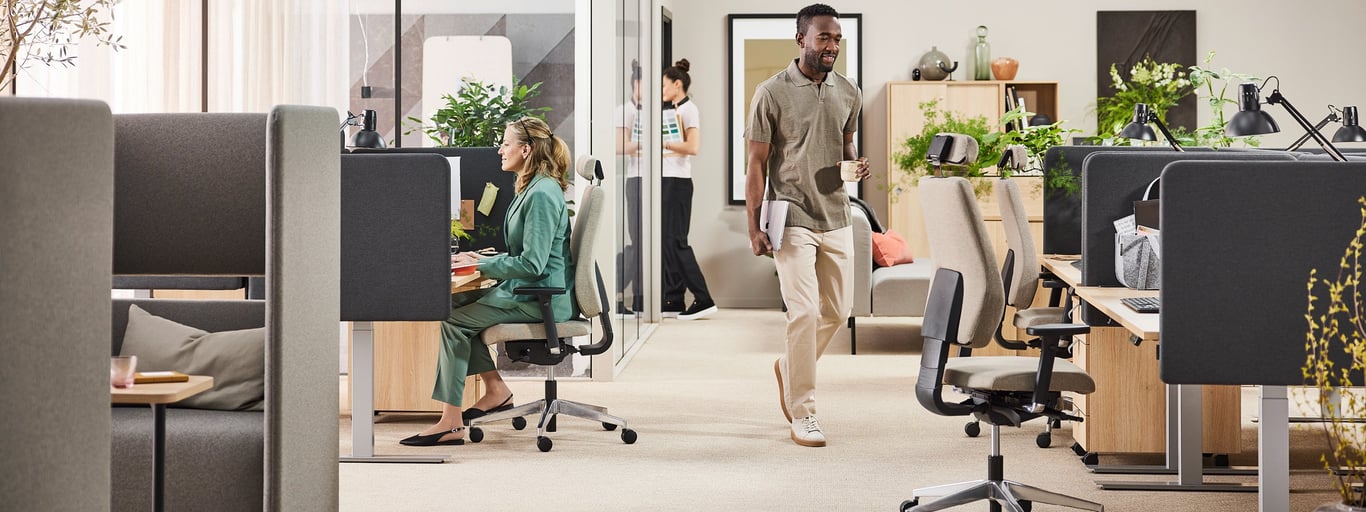
Modern & Stylish
Furnishing an office can be a real challenge and investment. To make the process easier, AJ Products has developed Modern & Stylish, a ready-made style concept with complete combinations of furniture that are all in stock for immediate delivery.
Need help? Ask our experts!
We at AJ Products are always available to help you with solutions suited just for your business. Contact us if you have questions on the choice of fabric, need some inspiration or want to know the alternatives that would best suit your premises. We can then tell you more about your choices.Get the latest product launches and offers sent direct to your inbox
Do you want to receive exclusive offers, information about new products and inspiration on how you can improve your workplace? Sign up for our free newsletter and be the first to receive our best offers.*By clicking subscribe, I confirm that I have read the privacy policy.
